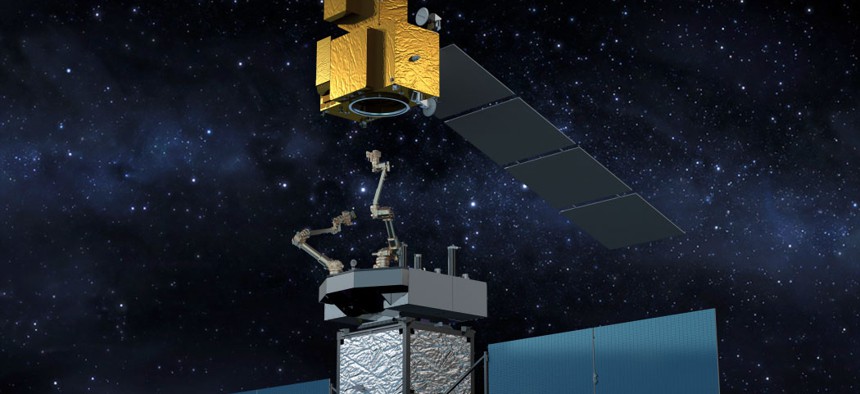US looks to expand the range of satellite-fixing robots
DARPA, aiming high in GEO, and NASA, aiming lower in LEO, are preparing to launch robotic satellite repair spacecraft.
With space junk looming as a concern for both military and commercial operators, NASA and the Defense Department are each looking at robotic systems that could service older satellites from low Earth orbit (LEO) all the way out to geosynchronous orbit (GEO).
NASA is currently aiming for a late 2019 launch of a robotic servicer spacecraft called Restore-L that would be equipped with tools that could be used to extend the life of failing satellites in polar low Earth orbit. The spacecraft would be capable of autonomous rendezvous and capture along with "telerobotic" refueling and relocation of satellites.
Program officials also stressed that Restore-L could service satellites not designed for on-orbit maintenance.
The Defense Advanced Research Projects Agency has launched a project to develop a robotic space craft that could service, upgrade and repair GEO satellites, which at 22,000 miles above the Earth are out of the reach of current technologies. But robotic servicing of satellites in LEO—about 900 to 1,200 miles above the Earth, where non-Moon-mission human spaceflights have taken place—also has appeal. The Hubble telescope, for instance, was successfully serviced by Shuttle astronauts, but that’s no longer an option since the Shuttle program was ended.
NASA's Satellite Servicing Capabilities Office said Restore-L servicing technologies would include a real-time navigation system based on sensors, algorithms and onboard processors that would safely guide the servicing spacecraft to its target. (NASA said initial "clients" for the proposed service would be U.S.-owned satellites in low Earth orbit.)
Restore-L also would be equipped with a pair of dexterous robotic arms capable of precise servicing missions, including avionics repairs and refueling. The tanker could deliver specific amounts of propellant at the required temperature, pressure and rate.
Benjamin Reed, NASA's deputy program manager for Restore-L development, told a recent industry conference that the proposed 2019 mission would attempt to service the Landsat 7 Earth observation satellite operated by NASA and the U.S. Geological Survey. Reed said Landsat 7 is expected to run out of propellant before a follow-on Landsat 9 mission can be launched.
Meanwhile, the Defense Advanced Research Projects Agency is focusing its robotic repair efforts on satellites orbiting about 22,000 above Earth. The agency's Robotic Servicing of Geosynchronous Satellites (RSGS) would includes a commercially developed spacecraft that would carry robotic arms and supporting technologies supplied by DARPA.
The payload would include a high-resolution inspection capability, repairs tools for "anomaly correction," including solar array or antenna deployment malfunctions; the ability to install upgraded components; and a "cooperative relocation" capability for shifting a failing satellite's orbit.
Geosynchronous orbits are ideal for providing round-the-clock satellite coverage for communications, weather observations and, for the military, reconnaissance and surveillance. Hence, the number of military, civilian government and commercial satellites in geosynchronous orbit is estimated to be in the hundreds.
With older military satellites reaching the end of their design lives, DARPA said it wants to work with commercial and other partners to develop new repair techniques at remote distances from Earth that currently preclude inspection and diagnosis, much less upgrades or repairs. The Naval Research Laboratory, for example, is contributing to the development of the RSGS project.
DARPA said in March it plans to solicit industry proposals for the robotic repair service "in the near future." It hopes to demonstrate inspection and servicing capabilities for satellites in geosynchronous orbit "within the next five years," program officials said.





